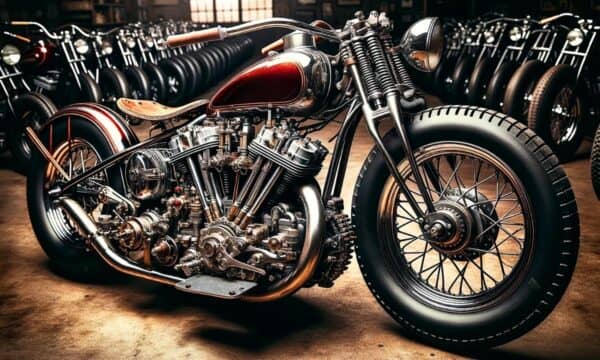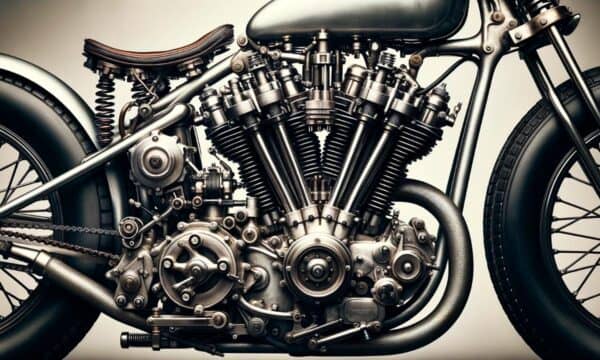The debate between Panhead and Shovelhead has long been a topic of interest among motorcycle enthusiasts.
Both engines, iconic creations of Harley-Davidson, have left an indelible mark on the history of motorcycling.
While they share many similarities, their distinct features and evolutions set them apart.
In this article, we’ll dive into the nuances of both engines, comparing their designs, performances, and legacies.
Let’s get started!
Panhead Vs Shovelhead Overview
| Features | Panhead | Shovelhead |
| Production Years | 1948 – 1965 | 1966 – 1985 |
| Strength | 50-55 horsepower | 55-60 horsepower |
| Engine Size | 61-74 cubic inch | 74-80 cubic inch |
| Engine | 1000-1200 cc | Reliable |
| Gear | 4 | 4-5 |
| Valve Design | Two-valve head with pushrod-operated valves | Overhead valve |
| Valve Covers Shape | Resemble small cake pans | Resemble the curve of a coal shovel (flipped) |
| Purpose of Design | Oil containment (though not fully successful) | Produce more power for heavier bikes |
| Cooling & Compression | N/A | Shallow chambers helped with cooling and worked |
| Notable Features | Leaks oil from the top end | Underwent a series of updates |
| Price | Higher | Relaible |
Panhead

The Panhead is a type of Harley-Davidson motorcycle engine that was manufactured from 1948 to 1965. It was named for its distinct, pan-shaped rocker covers.
The Panhead engine is known for its improved cooling, reduced oil leaks, and better oil pressure compared to its predecessor, the Knucklehead.
A significant upgrade came in 1955 with the introduction of hydraulic valve lifters, which made the engine quieter and reduced the need for frequent valve adjustments.
These improvements in both performance and reliability have made the Panhead a beloved choice among classic motorcycle enthusiasts.
Shovelhead

The Shovelhead engine, named for its distinctive, shovel-shaped rocker covers, was introduced by Harley-Davidson in 1966 as an upgrade to the Panhead.
This engine was designed to provide greater power and efficiency. It featured a 74 cubic inch displacement and higher compression for an increased horsepower output.
The Shovelhead also introduced a redesigned aluminum cylinder head that improved cooling and allowed the engine to run at higher RPMs for prolonged periods.
This engine type quickly gained popularity and was produced until 1984, becoming a signature component of Harley-Davidson’s classic motorcycles.
Detailed Comparison Between Panhead and Shovelhead
1. Engine Specifications
Introduced in 1948, the Panhead engine, with its distinctive pan-shaped rocker covers, was revered for its improved oil circulation and aluminum cylinder heads, which enabled better cooling.
It offered a power range of 50-55 horsepower and boasted a displacement of 1200cc or 1300cc, depending on the model.
In contrast, the Shovelhead engine, unveiled in 1966, earned its name from the shovel-shaped rocker covers.
It brought substantial improvements in power, delivering between 60 and 65 horsepower.
The Shovelhead also introduced a larger 1340cc displacement, thereby providing a significant performance upgrade.
Furthermore, its redesigned combustion chamber and valve ports ensured better airflow, which subsequently resulted in increased efficiency and power.
It’s clear that the Panhead marked a significant leap from its predecessors; the Shovelhead further pushed the boundaries with its power and performance enhancements.
2. Strength
The Panhead and Shovelhead engines offer different levels of strength and performance. The Panhead engine, with its 8.77 horsepower, had a 61 cubic inch engine.
The E engine had a compression ratio of 6.5 to 1, while the EL engine had a ratio of 7 to 1. Both engines had a bore and stroke of 3.3 inches and 3.5 inches, respectively.
On the other hand, the Shovelhead engine boasted a maximum of 66 horsepower, operating at 5,600 rpm. It was an 80 cubic inch engine.
However, in 1984, the power was reduced to 62 horsepower and the speed to 5400 rpm.
Between 1978 and 1980, the horsepower was further reduced to 60, but from 1981 to 1984, the company increased the power to 65.
3. Design and Appearance
When comparing the design and appearance of the Panhead and Shovelhead, several aspects stand out.
The Panhead is characterized by its bulbous covers resembling upside-down pans that give it a classic, vintage look.
Its design portrays the essence of the mid-century era, which makes it a favorite among retro motorcycle enthusiasts.
On the other hand, the Shovelhead’s design, named for its shovel-like rocker covers, is more streamlined and modern in appearance.
Its sleek, angular lines and cleaner aesthetic make it popular among riders seeking a blend of classic and contemporary styles.
Both engines offer distinctive looks that have made them iconic in the world of motorcycles.
4. Performance and Capability
When it comes to performance and capability, both Panhead and Shovelhead have unique strengths.
Panhead engines, known for their rocker covers, deliver smooth and reliable performance. They are appreciated for their stability, which makes them ideal for long journeys.
On the other hand, Shovelhead engines, with their improved valve design, offer an enhanced power output.
They are renowned for their raw, aggressive power, which makes them a favorite among those seeking a more exhilarating ride.
However, the Panhead engines tend to have a quieter operation compared to Shovelheads, which are known for their louder, more robust sound.
5. Features and Innovations
Panhead stands out with its aluminum heads, a feature which significantly reduces the engine weight and improves heat dissipation.
Additionally, the hydraulic valve lifters present in Panhead engines enhance overall engine performance by maintaining a zero valve clearance.
On the other hand, the Shovelhead’s most notable feature is its increased engine displacement, which offers a boost in horsepower, giving you a noticeable uptick in speed and power.
It’s also worth noting the improved oil circulation in Shovelhead engines. This innovation ensures better lubrication and cooling, which in turn increases the engine’s lifespan.
6. Bore And Stroke Design
The bore refers to the diameter of the engine’s cylinder, while the stroke is the distance the piston travels within the cylinder.
The Panhead has a smaller bore and longer stroke. This design maximizes the engine’s torque, giving you more power at low speeds.
On the other hand, the Shovelhead adopts a larger bore and shorter stroke design. This design prioritizes horsepower, and it gives you more power at high speeds.
7. Carburetor Design
The Panhead engine, typically paired with a Linkert carburetor, has a simplistic round slide design.
This design fosters reliable and quick throttle response, but it may require manual adjustment to maintain the optimum fuel-air mixture.
On the other hand, Shovelhead engines often come with Keihin carburetors. These are butterfly-style designs.
This design automatically adjusts the fuel-air mixture in response to changes in engine load and air pressure.
8. Structure
The two engines share some common features, such as both being V-twin motors with a displacement of 45 cubic inches.
The Panhead has an overhead valve design, while the Shovelhead has an overhead camshaft and pushrod arrangement. Both engines also have different types of air cooling systems.
The Panhead is also known for its low-end torque and power delivery, while the Shovelhead has more power at higher RPMs.
The Panhead has a powerful low-end torque and overhead valve design, which is great for cruising.
While the Shovelhead offers more power at higher RPMs due to its overhead camshaft and pushrod arrangement.
Advantages and Disadvantages of Panhead and Shovelhead
Pros of Panhead
- More fuel efficiency
- Smooth operation
- Reliable for long rides
Cons of Panhead
- Harder to tune
- Not optimal for fast accelerations
Pros of Shovelhead
- Great for rapid accelerations
- Easier to adjust and tune
Cons of Shovelhead
- Less fuel-efficient
- Potential for a rougher ride
Wrapping Up
The Panhead, with its improved cooling and oil pressure system, is often favored for its reliability and vintage charm.
On the other hand, the Shovelhead, offering enhanced power and performance, attracts those desiring a more robust and raw riding experience.
Both engines, with their shared Harley-Davidson lineage, bear striking resemblances in design and mechanics, making them equally treasured among motorcycle enthusiasts.
FAQs
Is the Harley Panhead the same as the Knucklehead?
The Harley Panhead and the Knucklehead are not the same; they are different models of Harley-Davidson motorcycles.
The Knucklehead was produced from 1936 to 1947, and the Panhead was introduced in 1948, succeeding the Knucklehead.
How efficient are Shovelhead engines in comparison to Panheads?
Shovelhead engines are generally more efficient than Panheads. They offer improved oil circulation and cooling, which leads to better performance and longevity.
However, the degree of efficiency can depend on the specific model and its maintenance history.
What is the typical lifespan of a Shovelhead?
The typical lifespan of a Shovelhead greatly depends on its maintenance and usage. However, with proper care, a Shovelhead can typically last for around 100,000 miles.
How can one identify a Harley Panhead visually?
A Harley Panhead can be visually identified by its distinct engine design. You should look for the engine’s two large cylindrical sections, known as heads, which have a pan-like shape.
They are rounded and flat on the bottom, resembling a cooking pan, hence the name “Panhead.”
You may like to read!

Ahtsham Younas is a passionate blogger and content writer. He loves to ride motorcycles and learn the mechanical process behind the motorcycles.
He has been writing articles in the motorcycle industry since 2019 and has learned many things about motorbike niches.


